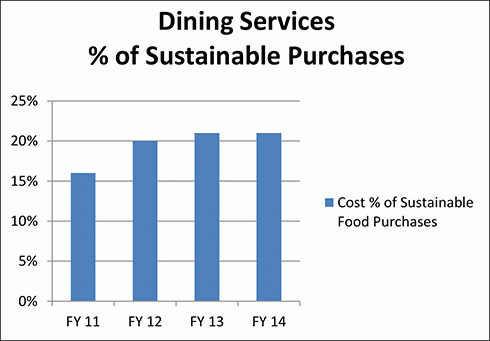
Food and Dining
Mount Holyoke College Dining Services works hard to stay within their budget while pleasing students and making efforts to be sustainable. Every year the college has Farm to College Week during which all the food is local, from within a radius of 150 miles. The prices and food available are always highly dependent of crops that year and Dining Services is often forced to shop around a bit more than usual to stay within the budget for this week. They have to put in the order for turkey, which they get from Diemend Farms in Wendell, Massachusetts, weeks in advance. This turkey costs about 30% more than the industrially produced turkey the college normally purchases.
About 15 years ago, Mount Holyoke Dining switched from normal coffee to Equal Exchange. This was propsed by a student and after careful deliberation using cost-benefit analysis, Dining Services decided that even though Equal Exchange is more expensive, it is worth it to promote sustainable and fair practices.
In 2005, composting was introduced to the dining halls. The compost goes to Farmers Friend in Belchertown, Massachusetts. This in an agricultural compost which mean that the humus (the soil produced from the compost) is used for agricultural purposes.
There has been talk about Mount Holyoke's dining becoming centralized, so instead of 8 smaller dining halls there would be one large dining hall. It is generally believed that this would be much more sustainable. This new dining facility would be more productive and efficient, yielding less waste. Less transportation would be needed, cutting down on greenhouse gas emissions, because only one food stop would be needed rather than 8 separate stops. Our current dining halls have not been renovated in many years and were designed for family style dining, not the current style of dining, so they are very out of date and innefficient especially in terms of energy use. The new building, except for the construction of it, would be much more efficient saving money on electricty and reducing greenhouse gas emissions.
In FY 2014, 21% of Dining Services' purchases were sustainable purchases. A sustainable pucharse includes anything that is locally grown, locally sourced, locally processed, organic, or fair-trade. This 21% is a 0.6% increase from 2013 which translates to $10,656 more spent on sustainable purchases. Dining Services intends to keep this percentage growing, however it is very expensive. Below the graph shows the percentage of sustainable purchases since 2011.

Besides increasing the percentage of sustainable purchases, there are a number of things the college could do to make our dining more sustainable. We could reduce waste by using compostable or reusable silverware in Blanchard. We could also start a chapter of the Food Recovery Network here. The Food Recovery Network is a nationwide organization that has chapters at many colleges and universities. The chapters recover leftovers from the dining halls and instead of composting this food, the chapters bring it to food kitchens to feed the hungry, reducing waste in a great way.
Information from: Nancy Apple, Richard Bigelow, Dale Hennessey, Rick Kroll,